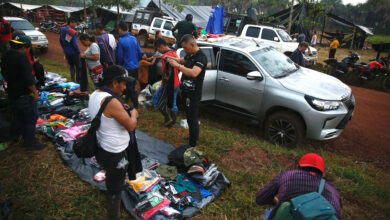Nagasaki survivors hope to be the last victims of nuclear weapons

By Edurne Morillo
Nagasaki, Japan, Aug 8 (EFE).- Survivors of Japan’s southern city of Nagasaki, the second location to be hit by a United States atomic bomb during World War II, hope they will be the last victims of nuclear weapons.
Hibakushas — a Japanese term for people affected by the Hiroshima and Nagasaki bombings at the end of World War II — are particularly worried about the war in Ukraine and the possibility of Russia launching an atomic bomb.
“The most worrying thing about the war in Ukraine is the possible use of nuclear weapons. It’s not like in the old days, they are much more sophisticated now and I worry about how the situation could escalate,” Mise Seiichiro, an 85-year-old survivor who was just over 3 km from the hypocentre of the blast when it hit, says.
Seiichiro was just 10 years old when the explosion hit Nagasaki on August 9, 1945. But 77 years later, the memory of war and the consequences of nuclear radiation are still very vivid.
“They are suffering what we are going through,” he says, referring to Ukrainians.
Seiichiro saw four of his family members suffer from cancer as a result of radiation.
When asked about Japanese political factions suggesting nuclear weapons could be necessary as a response to Russia’s aggression, Seiichiro is visibly angry.
“The politicians who are suggesting this did not live through the war,” he says.
Nagasaki’s mayor also believes having nuclear weapons is a risk that Japan should not be taking.
“Having nuclear weapons is a risk. We are always surrounded by this risk, and although future generations are being warned, this message has not reached everyone,” Tomihisa Taue says.
Japan, the only nation ever attacked by nuclear weapons, has not signed the Treaty on the Prohibition of Nuclear Weapons — which entered into force in 2021. The treaty includes the prohibition on the development, production, possession, use or threat of nuclear weapons as well as the allocation of aid for survivors and environmental remediation.
“This treaty is the only one that sends a clear message and everyone must be involved. We need Japan to send a clear message of peace,” says Taue.
Nagasaki has been using a strategy of peace education, in which pupils learn about the experience of the war and consequences of the atomic bomb.
One of the schools using this educational approach is Shiroyama primary school, located 500 meters from the blast and where 139 teachers and students were killed.
The so-called “Fat Man” bomb, which was dropped by US troops on Nagasaki at 11:02 am on August 9, 1945, destroyed over 40% of the city.
An estimated 40,000 people were killed instantly and futher 70,000 died in the following months.
Some 400,000 people lost their lives in both Hiroshima and Nagasaki, the two cities bombed with atomic weapons. EFE
emg/mp/ch





